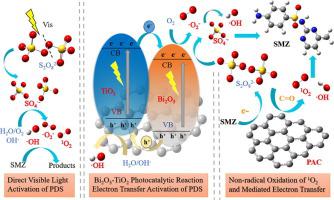当前位置:
X-MOL 学术
›
Chem. Eng. J.
›
论文详情
Our official English website, www.x-mol.net, welcomes your
feedback! (Note: you will need to create a separate account there.)
Synergistically boosting sulfamerazine degradation via activation of peroxydisulfate by photocatalysis of Bi2O3-TiO2/PAC under visible light irradiation
Chemical Engineering Journal ( IF 13.3 ) Pub Date : 2021-09-24 , DOI: 10.1016/j.cej.2021.132613 Jia-qi Li 1 , Zhi-wei Zhou 1, 2 , Xing Li 1 , Yan-ling Yang 1 , Jing-feng Gao 2 , Rui Yu 1 , Hui-ping Wang 1 , Nan Wang 3
Chemical Engineering Journal ( IF 13.3 ) Pub Date : 2021-09-24 , DOI: 10.1016/j.cej.2021.132613 Jia-qi Li 1 , Zhi-wei Zhou 1, 2 , Xing Li 1 , Yan-ling Yang 1 , Jing-feng Gao 2 , Rui Yu 1 , Hui-ping Wang 1 , Nan Wang 3
Affiliation

|
Photocatalysis-activated sulfate-radical advanced oxidation process (SR-AOP) is an effective approach to remove organic micropollutants from water. Here, we tested a photocatalysis-activated SR-AOP in which peroxydisulfate (PDS) was activated by composites of BiO-TiO photocatalyst supported onto commercial powdered activated carbon (BiO-TiO/PAC) under visible light irradiation. This “Vis-Cata-PDS” treatment exhibited outstanding degradation performance (97.96% removal) towards sulfamerazine (SMZ) following optimized reaction conditions of 0.1 g/L BiO-TiO/PAC and 0.1 g/L PDS at pH of 7. Synergistic effects were observed between the visible-light photocatalytic activation of PDS via direct electron transfer and nonradical PDS activation over pristine PAC within BiO-TiO/PAC. Both active radicals (SO, h, ·O) and nonradical singlet oxygen (O) and the mediated electron transfer of pristine PAC within BiO-TiO/PAC were contributed to SMZ degradation. Based on intermediates identified by Liquid Chromatograph-Mass Spectrometer (LC-MS) combined with density functional theory (DFT) calculations, three degradation pathways were proposed and that were mostly attributed to SO extrusion/Smiles-type rearrangement and S-N bond cleavage, and toxicity of intermediates were effectively alleviated. An inhibitory effect on SMZ degradation was observed for presence of HCO, whereas presence of SO was less inhibitory and Cl had no effect. The BiO-TiO/PAC composite displayed excellent reusability and stability, and it was effective towards a number of tested micropollutants (sulfadiazine, sulfamethoxazole, ciprofloxacin, bisphenol A and methyl orange) and in real water matrixes. This work offers deep insights into the nonradical oxidation mechanism and application of Vis-Cata-PDS over a BiO-TiO/PAC composite for removal of organic micropollutants.
中文翻译:

可见光照射下 Bi2O3-TiO2/PAC 光催化活化过二硫酸盐协同促进磺胺嘧啶降解
光催化激活硫酸盐-自由基高级氧化工艺(SR-AOP)是去除水中有机微污染物的有效方法。在这里,我们测试了一种光催化激活的 SR-AOP,其中过二硫酸盐 (PDS) 在可见光照射下被负载在商用粉末活性炭 (BiO-TiO/PAC) 上的 Bi2O-TiO2 光催化剂复合材料激活。在 pH 值为 7 的 0.1 g/L BiO-TiO/PAC 和 0.1 g/L PDS 的优化反应条件下,这种“Vis-Cata-PDS”处理对磺胺甲基嘧啶 (SMZ) 表现出出色的降解性能(97.96% 去除率)。 协同效应在 BiO-TiO/PAC 内的原始 PAC 上通过直接电子转移对 PDS 进行可见光光催化活化和非自由基 PDS 活化之间观察到了差异。活性自由基(SO、h、·O)和非自由基单线态氧(O)以及 BiO-TiO/PAC 内原始 PAC 介导的电子转移均导致 SMZ 降解。基于液相色谱-质谱联用仪 (LC-MS) 鉴定的中间体结合密度泛函理论 (DFT) 计算,提出了三种降解途径,主要归因于 SO 挤出/Smiles 型重排和 SN 键断裂以及毒性中间产物得到有效缓解。观察到 HCO 的存在对 SMZ 降解有抑制作用,而 SO 的存在抑制作用较小,Cl 没有影响。 BiO-TiO/PAC复合材料表现出优异的可重复使用性和稳定性,并且对许多测试的微污染物(磺胺嘧啶、磺胺甲恶唑、环丙沙星、双酚A和甲基橙)和真实水基质有效。这项工作深入了解了非自由基氧化机制以及 Vis-Cata-PDS 在 BiO-TiO/PAC 复合材料上去除有机微污染物的应用。
更新日期:2021-09-24
中文翻译:

可见光照射下 Bi2O3-TiO2/PAC 光催化活化过二硫酸盐协同促进磺胺嘧啶降解
光催化激活硫酸盐-自由基高级氧化工艺(SR-AOP)是去除水中有机微污染物的有效方法。在这里,我们测试了一种光催化激活的 SR-AOP,其中过二硫酸盐 (PDS) 在可见光照射下被负载在商用粉末活性炭 (BiO-TiO/PAC) 上的 Bi2O-TiO2 光催化剂复合材料激活。在 pH 值为 7 的 0.1 g/L BiO-TiO/PAC 和 0.1 g/L PDS 的优化反应条件下,这种“Vis-Cata-PDS”处理对磺胺甲基嘧啶 (SMZ) 表现出出色的降解性能(97.96% 去除率)。 协同效应在 BiO-TiO/PAC 内的原始 PAC 上通过直接电子转移对 PDS 进行可见光光催化活化和非自由基 PDS 活化之间观察到了差异。活性自由基(SO、h、·O)和非自由基单线态氧(O)以及 BiO-TiO/PAC 内原始 PAC 介导的电子转移均导致 SMZ 降解。基于液相色谱-质谱联用仪 (LC-MS) 鉴定的中间体结合密度泛函理论 (DFT) 计算,提出了三种降解途径,主要归因于 SO 挤出/Smiles 型重排和 SN 键断裂以及毒性中间产物得到有效缓解。观察到 HCO 的存在对 SMZ 降解有抑制作用,而 SO 的存在抑制作用较小,Cl 没有影响。 BiO-TiO/PAC复合材料表现出优异的可重复使用性和稳定性,并且对许多测试的微污染物(磺胺嘧啶、磺胺甲恶唑、环丙沙星、双酚A和甲基橙)和真实水基质有效。这项工作深入了解了非自由基氧化机制以及 Vis-Cata-PDS 在 BiO-TiO/PAC 复合材料上去除有机微污染物的应用。











































 京公网安备 11010802027423号
京公网安备 11010802027423号